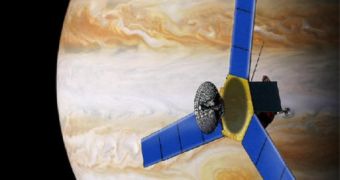At long last, the biggest planet in our solar system is given the proper attention again, after about 13 years. Following a long series of delays and cancellations (both in this case and for previous suggested missions), NASA has finally decided to send an orbiter to Jupiter. The probe which has made it is called Juno and will perform unprecedented scientific operations from an elliptical polar orbit above the gaseous giant.
The Juno project has managed to overcome budget recalculations and delays. It is slated to be launched in August 2011 and reach its destination five years later. Once there, it will perform 32 highly-elliptical orbits around Jupiter from an altitude of 3,000 miles (about 4,830 km) above the planet's cloudy ceiling during one year. It is the first probe designed to operate on solar power at such a distance from the Sun.
"Jupiter is more than 400 million miles from the sun or five times further than Earth," explained Scott Bolton, principal investigator for Juno at San Antonio's Southwest Research Institute, quoted by Universe Today. "Juno is engineered to be extremely energy efficient." Talking about the relevance of Juno's mission, James Green, NASA's Planetary Division director, shared that "Juno gives us a fantastic opportunity to get a picture of the structure of Jupiter in a way never before possible. It will allow us to take a giant step forward in our understanding on how giant planets form and the role that plays in putting the rest of the solar system together".
The probe will make use of its nine instruments and a camera to observe the planet in greater detail, focusing on the existence of ice-rock cores, the planet's magnetic field, water and ammonia atmospheric clouds and aurora. "Jupiter is the archetype of giant planets in our solar system and formed very early, capturing most of the material left after the Sun formed," stated Bolton. "Unlike Earth, Jupiter's giant mass allowed it to hold onto its original composition, providing us with a way of tracing our solar system's history."

 14 DAY TRIAL //
14 DAY TRIAL //